Kelly Jensen's Blog, page 138
August 4, 2013
Get Genrefied*: Graphic Novels
Every month, we're highlighting one genre within YA fiction as part of Angela's reader's advisory challenge. So far, we've discussed horror, science fiction, high fantasy, mysteries and thrillers, verse novels, contemporary realistic fiction, and historical fiction. August's focus is graphic novels, a wide, wide world that actually includes all genres under the sun.
The simplest definition of a graphic novel, as librarians use it, is a book-length comic. The term is actually a little misleading, since many of the books we generally call graphic "novels" - like nonfiction - are not novels at all. (Why we don't just call them graphic books I will never understand. Can you tell it bugs me a little to have to call a nonfiction book a novel? It does.) A comic is sequential art, usually incorporating panels with speech bubbles or captions as opposed to traditional paragraphs of text. It's the "sequential" that sets it apart from, say, a picture book.
The graphic novel format is incredibly broad, because it can really tell any kind of story you can imagine (both fiction and nonfiction). Graphic novels can include (but are not limited to):
Graphic adaptations of classics, like Ray Bradbury's Fahrenheit 451 or Jane Austen's Pride and Prejudice. (The quality of these is incredibly spotty. Professional reviews are essential before selecting them for the library.)
Graphic adaptations of more current and popular titles, such as Twilight, Artemis Fowl, Beautiful Creatures, and the upcoming Miss Peregrine's Home for Peculiar Children and Speak.
Collections of complete story arcs featuring superheroes and other traditional comic book protagonists, such as the recent Avengers vs. X-Men. These are multiple issues of a particular comic book collected in a single volume. The volume will have a unifying story with a beginning, middle, and end.
Other continuous series that don't necessarily fit into the superhero mold, such as My Boyfriend is a Monster.
Manga (Japanese comics). My knowledge of manga is limited, so I rely a lot on professional reviews and the teens to tell me what they want to read. Perennial favorites include Bleach, Naruto, and Fruits Basket.
Graphic novel spinoffs or side stories of popular tv series, including Doctor Who and Buffy the Vampire Slayer.
And the books that we'll be primarily focusing on in this guide: the standalones (or occasional short series), the more typical "novel" sort of book originally written as a book and not as a series of strips, single-issue comics, or based on a previous story in another format or media type. Examples of this include Anya's Ghost and American Born Chinese. This category also includes some really excellent and creative nonfiction, such as My Friend Dahmer.
With such a broad topic, it's helpful to know where to find more information. I've found the following resources valuable or interesting in one way or another in the years I've been selecting graphic novels for teens:
No Flying, No Tights is an invaluable resource that's continuously updated with reviews of graphic novels for teens (plus some for younger kids and adults). It's run by a teen librarian, and it caters to a librarian audience.
Comics Worth Reading is another blog worth checking out. They review titles and discuss news. They also have a section dedicated to comics by women.
First Second and Graphic Universe (graphic novel imprints of Macmillan and Lerner, respectively) both run blogs with information about graphic novels beyond plugs for their own books. Graphic Universe's hasn't been updated since 2012.
School Library Journal runs the Good Comics for Kids blog which discusses all things graphic novels for kids, including news and reviews.
Comics Alliance and Comic Book Resources are news and opinion sites about comic book culture. Neither are tied to any particular publishing house.
Kelly pointed this out this past weekend: The Richland Library has collected a list of graphic novels adapted from traditional books (both classic and contemporary).
There are several awards and professional recommended reading lists available for YA graphic novels:
The Eisner Awards, named after graphic novelist Will Eisner, are the biggie. They have a specific category for teens ages 13-17, but a lot of the adult titles honored will have crossover appeal.
The Cybils honor the best graphic novel for teens each year (I participated as a round 2 judge last year).
The ALA produces a list of Great Graphic Novels for Teens each year. Many of the titles on this list are books published for the adult market with crossover appeal. They also include a good bit of manga and superhero comics.
The Texas Library Association has the Maverick Graphic Novel reading list (the first of its kind in the nation), which helpfully divides the books into grades 6-8, 6-12, 9-12, and adult with teen appeal.
And finally, while most major publishing houses that produce traditional books also regularly put out some graphic novels each year (such as Candlewick and Houghton Mifflin), it's good to also be aware of the major publishers and imprints dedicated to graphic novels. Note that most of the publishers listed below publish for all ages, with some books appropriate for a teen collection and some not:
First Second (an imprint of Macmillan)
Graphix (an imprint of Scholastic, mainly middle grade with some crossover to YA)
Graphic Universe (an imprint of Lerner)
Papercutz (mainly children's and middle grade with a lot of licensed content that appeals to all ages)
Fantagraphics
Drawn + Quarterly
The Center for Cartoon Studies (this is actually a school for aspiring professional graphic novelists that puts out some thoughtful, unique stuff)
Major monthly comic book publishers (whose issues are then collected into graphic novels), including DC, Marvel, IDW, Dark Horse, Image, Dynamite, Oni Press, and BOOM! Studios
Manga publishers in the United States, including Viz, Tokyopop, and Yen Press
Below are some graphic novels for teens published within the last year or so. All descriptions come from Worldcat or Goodreads.


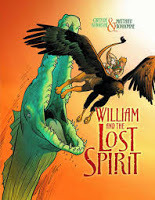
A Game for Swallows: To Die, to Leave, to Return by Zeina Abirached: Living in the midst of civil war in Beirut, Lebanon, Zeina and her
brother face an evening of apprehension when their parents do not return
from a visit to the other side of the city.
William and the Lost Spirit by Gwen de Bonneval, illustrated by Matthieu Bonhomme: In this graphic novel that combines medieval legends and folklore, the
brutish feudal world, and devotion to family, William, the grandson of
an elderly feudal lord in the thirteenth century, sets out on a
labyrinthine journey to discover his father's killer.
Broxo by Zach Giallongo: Broxo, the only surviving member of a tribe of barbarians, spends his
time on a mountain hunting and avoiding the man-eating walking dead
until everything changes when Zora, a foreign princess, arrives on the
mountain seeking Broxo's lost tribe.
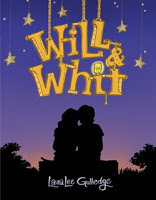
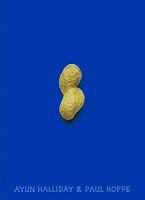

Will & Whit by Laura Lee Gulledge: Wilhelmina "Will" Huxstep is a creative soul struggling to come to terms
with a family tragedy. She crafts whimsical lamps, in part to deal with
her fear of the dark. As she wraps up another summer in her mountain
town, she longs for unplugged adventures with her fellow creative
friends, Autumn, Noel, and Reese. Little does she know that she will get
her wish in the form of an arts carnival and a blackout, courtesy of a hurricane named Whitney, which forces Will to face her fear of darkness.
Peanut by Ayun Halliday: Nervous about starting her sophomore year at a new high school, Sadie
decides to make herself more interesting by claiming to be allergic to
peanuts, but her lie quickly spirals out of control.
Marble Season by Gilbert Hernandez: Middle child Huey stages Captain America plays and treasures his older brother's comic book collection almost as much as his approval. "Marble Season" subtly and deftly details how the innocent, joyfully creative play that children engage in (shooting marbles, backyard performances, and organizing treasure hunts) changes as they grow older and encounter name-calling naysayers, abusive bullies, and the value judgments of other kids.

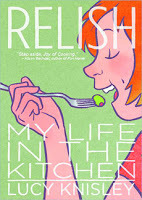
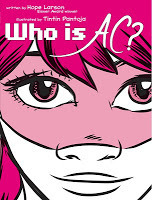
Tina's Mouth by Keshni Kashyap and Mari Araki: Tina Malhotra, a sophomore at the Yarborough Academy in Southern California, creates an existential diary for an honors English assignment in which she tries to determine who she is and where she fits in.
Relish: My Life in the Kitchen by
Lucy Knisley: Lucy Knisley loves food. The daughter of a chef and a
gourmet, this talented young cartoonist comes by her obsession honestly.
In her forthright, thoughtful, and funny memoir, Lucy traces key
episodes in her life thus far, framed by what she was eating at the time
and lessons learned about food, cooking, and life. Each chapter is
bookended with an illustrated recipe-- many of them treasured family
dishes, and a few of them Lucy's original inventions.
Who is AC? by Hope Larson, illustrated by Tintin Pantoja: Meet Lin, an average teenage girl who is zapped with magical powers
through her cell phone. But just as superpowers can travel through the
ether, so can evil. And as Lin starts to get a handle on her powers
(while still observing her curfew!) she realizes she has to go head to
head with a nefarious villain who spreads his influence through binary
code.
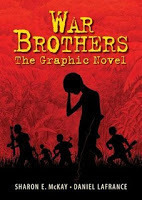

War Brothers: The Graphic Novel by Sharon E. McKay, illustrated by Daniel Lafrance: Jacob is a 14-year-old Ugandan who is sent away to a boys' school. Once
there, he assures his friend Tony that they need not be afraid -- they
will be safe. But not long after, in the shadow of the night, the boys
are abducted. Marched into the jungle, they are brought to an encampment
of the feared rebel soldiers. They are told they must kill or be
killed, and their world turns into a terrifying struggle to endure and survive.
Primates by Jim Ottaviani, illustrated by Maris Wicks: Jim Ottaviani returns
with an action-packed account of the three greatest primatologists of the
last century: Jane Goodall, Dian Fossey, and Biruté Galdikas.
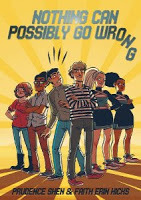
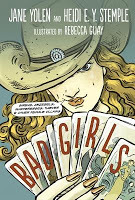
Nothing Can Possibly Go Wrong by Prudence Shen and Faith Erin Hicks: Charlie is the laid-back captain of the basketball team. Nate is the neurotic, scheming president of the robotics club. Their unlikely friendship nearly bites the dust when Nate declares war on the cheerleaders and they retaliate by making Charlie their figurehead in the ugliest class election campaign the school has ever seen.
Bad Girls: Sirens, Jezebels, Murderesses, Thieves, and Other Female Villains by Jane Yolen and Heidi E. Y. Stemple, illustrated by Rebecca Guay: Harlot or hero? Liar or lady? There are two sides to every story. Meet
twenty-six of history's most notorious women, and debate alongside
authors Yolen and Stemple--who appear in the book as themselves in a
series of comic panels--as to each girl's guilt or innocence.
And here are a few to look for in the coming months.
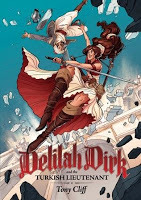
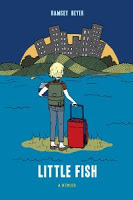
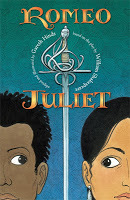
Delilah Dirk and the Turkish Lieutenant by Tony Cliff: Lovable ne'er-do-well Delilah Dirk is an Indiana Jones for the 19th
century. She has traveled to Japan, Indonesia, France, and even the New
World. Using the skills she's picked up on the way, Delilah's adventures
continue as she plots to rob a rich and corrupt Sultan in
Constantinople. With the aid of her flying boat and her newfound friend,
Selim, she evades the Sultan's guards, leaves angry pirates in the
dust, and fights her way through the countryside. (August 2013)
Little Fish by Ramsey Beyer: Told through real-life
journals, collages, lists, and drawings, this coming-of-age story
illustrates the transformation of an 18-year-old girl from a small-town
teenager into an independent city-dwelling college student. (September 2013)
Romeo and Juliet adapted by Gareth Hinds: Gareth Hinds’
stylish graphic adaptation of the Bard’s romantic tragedy offers modern
touches — including a diverse cast that underscores the story’s
universality. (September 2013)
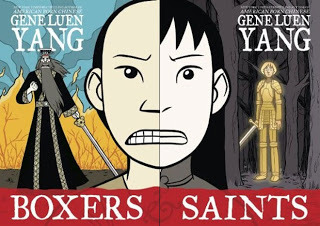
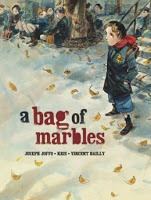
Boxers & Saints by Gene Luen Yang: Boxers & Saints is
an innovative new graphic novel in two volumes - the parallel stories of
two young people caught up on opposite sides of a violent rift. American Born Chinese author
Gene Luen Yang brings his clear-eyed storytelling and trademark magical
realism to the complexities of the Boxer Rebellion and lays bare the
foundations of extremism, rebellion, and faith. (September 2013)
A Bag of Marbles: The Graphic Novel by Joseph Joffo, illustrated by Vincent Bailly: In 1941, ten-year-old Joseph Joffo and his older brother, Maurice,
must hide their Jewish heritage and undertake a long and dangerous
journey from Nazi-occupied Paris to reach their other brothers in the
free zone. (October 2013)
We'd really love it if you'd help flesh out these lists some. Do you know of any forthcoming or recently-published graphic novels for teens? Let us know in the comments.
*I (Kimberly) strongly considered changing the title of this post to
something other than "genrefied," since graphic novels are not, by
definition, a genre. They're a format. Ultimately, consistency won out.







 Related StoriesGet Genrefied: Historical FictionDelilah Dirk and the Turkish Lieutenant by Tony CliffComplicated Father Relationships: A YA Reading List
Related StoriesGet Genrefied: Historical FictionDelilah Dirk and the Turkish Lieutenant by Tony CliffComplicated Father Relationships: A YA Reading List
The simplest definition of a graphic novel, as librarians use it, is a book-length comic. The term is actually a little misleading, since many of the books we generally call graphic "novels" - like nonfiction - are not novels at all. (Why we don't just call them graphic books I will never understand. Can you tell it bugs me a little to have to call a nonfiction book a novel? It does.) A comic is sequential art, usually incorporating panels with speech bubbles or captions as opposed to traditional paragraphs of text. It's the "sequential" that sets it apart from, say, a picture book.
The graphic novel format is incredibly broad, because it can really tell any kind of story you can imagine (both fiction and nonfiction). Graphic novels can include (but are not limited to):
Graphic adaptations of classics, like Ray Bradbury's Fahrenheit 451 or Jane Austen's Pride and Prejudice. (The quality of these is incredibly spotty. Professional reviews are essential before selecting them for the library.)
Graphic adaptations of more current and popular titles, such as Twilight, Artemis Fowl, Beautiful Creatures, and the upcoming Miss Peregrine's Home for Peculiar Children and Speak.
Collections of complete story arcs featuring superheroes and other traditional comic book protagonists, such as the recent Avengers vs. X-Men. These are multiple issues of a particular comic book collected in a single volume. The volume will have a unifying story with a beginning, middle, and end.
Other continuous series that don't necessarily fit into the superhero mold, such as My Boyfriend is a Monster.
Manga (Japanese comics). My knowledge of manga is limited, so I rely a lot on professional reviews and the teens to tell me what they want to read. Perennial favorites include Bleach, Naruto, and Fruits Basket.
Graphic novel spinoffs or side stories of popular tv series, including Doctor Who and Buffy the Vampire Slayer.
And the books that we'll be primarily focusing on in this guide: the standalones (or occasional short series), the more typical "novel" sort of book originally written as a book and not as a series of strips, single-issue comics, or based on a previous story in another format or media type. Examples of this include Anya's Ghost and American Born Chinese. This category also includes some really excellent and creative nonfiction, such as My Friend Dahmer.
With such a broad topic, it's helpful to know where to find more information. I've found the following resources valuable or interesting in one way or another in the years I've been selecting graphic novels for teens:
No Flying, No Tights is an invaluable resource that's continuously updated with reviews of graphic novels for teens (plus some for younger kids and adults). It's run by a teen librarian, and it caters to a librarian audience.
Comics Worth Reading is another blog worth checking out. They review titles and discuss news. They also have a section dedicated to comics by women.
First Second and Graphic Universe (graphic novel imprints of Macmillan and Lerner, respectively) both run blogs with information about graphic novels beyond plugs for their own books. Graphic Universe's hasn't been updated since 2012.
School Library Journal runs the Good Comics for Kids blog which discusses all things graphic novels for kids, including news and reviews.
Comics Alliance and Comic Book Resources are news and opinion sites about comic book culture. Neither are tied to any particular publishing house.
Kelly pointed this out this past weekend: The Richland Library has collected a list of graphic novels adapted from traditional books (both classic and contemporary).
There are several awards and professional recommended reading lists available for YA graphic novels:
The Eisner Awards, named after graphic novelist Will Eisner, are the biggie. They have a specific category for teens ages 13-17, but a lot of the adult titles honored will have crossover appeal.
The Cybils honor the best graphic novel for teens each year (I participated as a round 2 judge last year).
The ALA produces a list of Great Graphic Novels for Teens each year. Many of the titles on this list are books published for the adult market with crossover appeal. They also include a good bit of manga and superhero comics.
The Texas Library Association has the Maverick Graphic Novel reading list (the first of its kind in the nation), which helpfully divides the books into grades 6-8, 6-12, 9-12, and adult with teen appeal.
And finally, while most major publishing houses that produce traditional books also regularly put out some graphic novels each year (such as Candlewick and Houghton Mifflin), it's good to also be aware of the major publishers and imprints dedicated to graphic novels. Note that most of the publishers listed below publish for all ages, with some books appropriate for a teen collection and some not:
First Second (an imprint of Macmillan)
Graphix (an imprint of Scholastic, mainly middle grade with some crossover to YA)
Graphic Universe (an imprint of Lerner)
Papercutz (mainly children's and middle grade with a lot of licensed content that appeals to all ages)
Fantagraphics
Drawn + Quarterly
The Center for Cartoon Studies (this is actually a school for aspiring professional graphic novelists that puts out some thoughtful, unique stuff)
Major monthly comic book publishers (whose issues are then collected into graphic novels), including DC, Marvel, IDW, Dark Horse, Image, Dynamite, Oni Press, and BOOM! Studios
Manga publishers in the United States, including Viz, Tokyopop, and Yen Press
Below are some graphic novels for teens published within the last year or so. All descriptions come from Worldcat or Goodreads.



A Game for Swallows: To Die, to Leave, to Return by Zeina Abirached: Living in the midst of civil war in Beirut, Lebanon, Zeina and her
brother face an evening of apprehension when their parents do not return
from a visit to the other side of the city.
William and the Lost Spirit by Gwen de Bonneval, illustrated by Matthieu Bonhomme: In this graphic novel that combines medieval legends and folklore, the
brutish feudal world, and devotion to family, William, the grandson of
an elderly feudal lord in the thirteenth century, sets out on a
labyrinthine journey to discover his father's killer.
Broxo by Zach Giallongo: Broxo, the only surviving member of a tribe of barbarians, spends his
time on a mountain hunting and avoiding the man-eating walking dead
until everything changes when Zora, a foreign princess, arrives on the
mountain seeking Broxo's lost tribe.



Will & Whit by Laura Lee Gulledge: Wilhelmina "Will" Huxstep is a creative soul struggling to come to terms
with a family tragedy. She crafts whimsical lamps, in part to deal with
her fear of the dark. As she wraps up another summer in her mountain
town, she longs for unplugged adventures with her fellow creative
friends, Autumn, Noel, and Reese. Little does she know that she will get
her wish in the form of an arts carnival and a blackout, courtesy of a hurricane named Whitney, which forces Will to face her fear of darkness.
Peanut by Ayun Halliday: Nervous about starting her sophomore year at a new high school, Sadie
decides to make herself more interesting by claiming to be allergic to
peanuts, but her lie quickly spirals out of control.
Marble Season by Gilbert Hernandez: Middle child Huey stages Captain America plays and treasures his older brother's comic book collection almost as much as his approval. "Marble Season" subtly and deftly details how the innocent, joyfully creative play that children engage in (shooting marbles, backyard performances, and organizing treasure hunts) changes as they grow older and encounter name-calling naysayers, abusive bullies, and the value judgments of other kids.



Tina's Mouth by Keshni Kashyap and Mari Araki: Tina Malhotra, a sophomore at the Yarborough Academy in Southern California, creates an existential diary for an honors English assignment in which she tries to determine who she is and where she fits in.
Relish: My Life in the Kitchen by
Lucy Knisley: Lucy Knisley loves food. The daughter of a chef and a
gourmet, this talented young cartoonist comes by her obsession honestly.
In her forthright, thoughtful, and funny memoir, Lucy traces key
episodes in her life thus far, framed by what she was eating at the time
and lessons learned about food, cooking, and life. Each chapter is
bookended with an illustrated recipe-- many of them treasured family
dishes, and a few of them Lucy's original inventions.
Who is AC? by Hope Larson, illustrated by Tintin Pantoja: Meet Lin, an average teenage girl who is zapped with magical powers
through her cell phone. But just as superpowers can travel through the
ether, so can evil. And as Lin starts to get a handle on her powers
(while still observing her curfew!) she realizes she has to go head to
head with a nefarious villain who spreads his influence through binary
code.


War Brothers: The Graphic Novel by Sharon E. McKay, illustrated by Daniel Lafrance: Jacob is a 14-year-old Ugandan who is sent away to a boys' school. Once
there, he assures his friend Tony that they need not be afraid -- they
will be safe. But not long after, in the shadow of the night, the boys
are abducted. Marched into the jungle, they are brought to an encampment
of the feared rebel soldiers. They are told they must kill or be
killed, and their world turns into a terrifying struggle to endure and survive.
Primates by Jim Ottaviani, illustrated by Maris Wicks: Jim Ottaviani returns
with an action-packed account of the three greatest primatologists of the
last century: Jane Goodall, Dian Fossey, and Biruté Galdikas.


Nothing Can Possibly Go Wrong by Prudence Shen and Faith Erin Hicks: Charlie is the laid-back captain of the basketball team. Nate is the neurotic, scheming president of the robotics club. Their unlikely friendship nearly bites the dust when Nate declares war on the cheerleaders and they retaliate by making Charlie their figurehead in the ugliest class election campaign the school has ever seen.
Bad Girls: Sirens, Jezebels, Murderesses, Thieves, and Other Female Villains by Jane Yolen and Heidi E. Y. Stemple, illustrated by Rebecca Guay: Harlot or hero? Liar or lady? There are two sides to every story. Meet
twenty-six of history's most notorious women, and debate alongside
authors Yolen and Stemple--who appear in the book as themselves in a
series of comic panels--as to each girl's guilt or innocence.
And here are a few to look for in the coming months.



Delilah Dirk and the Turkish Lieutenant by Tony Cliff: Lovable ne'er-do-well Delilah Dirk is an Indiana Jones for the 19th
century. She has traveled to Japan, Indonesia, France, and even the New
World. Using the skills she's picked up on the way, Delilah's adventures
continue as she plots to rob a rich and corrupt Sultan in
Constantinople. With the aid of her flying boat and her newfound friend,
Selim, she evades the Sultan's guards, leaves angry pirates in the
dust, and fights her way through the countryside. (August 2013)
Little Fish by Ramsey Beyer: Told through real-life
journals, collages, lists, and drawings, this coming-of-age story
illustrates the transformation of an 18-year-old girl from a small-town
teenager into an independent city-dwelling college student. (September 2013)
Romeo and Juliet adapted by Gareth Hinds: Gareth Hinds’
stylish graphic adaptation of the Bard’s romantic tragedy offers modern
touches — including a diverse cast that underscores the story’s
universality. (September 2013)


Boxers & Saints by Gene Luen Yang: Boxers & Saints is
an innovative new graphic novel in two volumes - the parallel stories of
two young people caught up on opposite sides of a violent rift. American Born Chinese author
Gene Luen Yang brings his clear-eyed storytelling and trademark magical
realism to the complexities of the Boxer Rebellion and lays bare the
foundations of extremism, rebellion, and faith. (September 2013)
A Bag of Marbles: The Graphic Novel by Joseph Joffo, illustrated by Vincent Bailly: In 1941, ten-year-old Joseph Joffo and his older brother, Maurice,
must hide their Jewish heritage and undertake a long and dangerous
journey from Nazi-occupied Paris to reach their other brothers in the
free zone. (October 2013)
We'd really love it if you'd help flesh out these lists some. Do you know of any forthcoming or recently-published graphic novels for teens? Let us know in the comments.
*I (Kimberly) strongly considered changing the title of this post to
something other than "genrefied," since graphic novels are not, by
definition, a genre. They're a format. Ultimately, consistency won out.







 Related StoriesGet Genrefied: Historical FictionDelilah Dirk and the Turkish Lieutenant by Tony CliffComplicated Father Relationships: A YA Reading List
Related StoriesGet Genrefied: Historical FictionDelilah Dirk and the Turkish Lieutenant by Tony CliffComplicated Father Relationships: A YA Reading List
Published on August 04, 2013 22:00
August 2, 2013
Links of Note: August 3, 2013
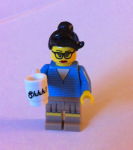
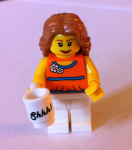

Ready to dive in to the pile of interesting reads from around the library/book/reading web? Because I have plenty.
The Lego mini-figs above come from this amusing discussion of librarian stereotypes and how Lego's creation of an official Librarian mini fig may or may not mean something. I laughed since so many of the examples are spot on.
Someone give Leila an award for doing this -- she tested out all of those digital book recommendation services and tells what works best and what does. What an awesome reference guide (and introduction to some services that maybe you didn't already know existed).
What does J. K. Rowling's pseudonymous novel say about commercial success? A short but interesting piece.
The more I read Roger Sutton, the more I love him. And I feel like he so perfectly nails something I was thinking about certain listicles that keep popping up: do you mean "might like?"
Jennie talks about why "exclusive editions" of books are bad for libraries. I like this not only because it's true, but I like it because it raises some good questions about other "exclusive" sorts of books are out there that do put library users at a disadvantage. Digital-only books? Not easy to get for readers who might want them -- same with digital shorts. We want to get these things into the hands of our teens but our hands are often tied.
Rebecca Schinsky busts down the myth that Generation Y or the Millennials or whatever the heck this group is called is only interested in Angry Birds and texting. They want and crave reading because it's an activity they enjoy.
Next week, we're doing a ton of posts about graphic novels, since it's the genre of the month (yes, you'll get a genre guide, an awesome Twitterview, as well as reviews and more). I stumbled upon this great reader's advisory guide by Tom over at his library's website worth reading: here's a list of graphic novels that are adaptations of books, both classic literature and more contemporary works.
I feel like everyone has read or shared this one already, but it won't hurt to do it again. Linda Holmes from NPR's Monkey See wrote an incredible piece about being an oddball and how those dreams and schemes that seem unachievable or that seem like the kinds of things no one would ever be interested in are worth pursuing. This is super positive and uplifting reading.
Beverly Beckham wrote a really sweet piece to one of her first mentors and someone whose insight helped shape her own career: Robert Cormier.
A thought-provoking post by Megan at the Book Brats wonders about science fact in YA science fiction.
Are you in Chicago? You should check out the exhibit at Galerie F that pays homage to Roald Dahl's books. Even if you can't make it to see in person, you can check out some of the art on the Galerie's website.
I stumbled upon a really interesting and thought-provoking piece last week which asks what the Bechdel test could add to YA literature. This topic popped up again over at the Pub Crawl blog, which explores the idea of what womance could add to YA fiction.
I get why dust jackets exist, but I am the lady who takes them off hard covers and uses them as page markers until I am done with the book. I put them back on after...usually. Flavorwire has a piece dedicated to the dislike of the dust jacket.
Here's one for those of you who love book covers: four designers show off their concepts throughout the stages of design and what ended up working and not working. After you read that one, go check out this post on Lerner's blog about the cover design process for Carrie Mesrobian's forthcoming Sex & Violence. I love these behind-the-scenes, cutting room floor sorts of pieces.
Are you watching Orange is the New Black? Curious about what books are getting a little time on screen? Toby at Skokie Public Library rounded them up into an awesome reader's guide on the library's website.
I have a lot of opinions about Book Trailers, and so I love this piece over at Book Riot about what makes for a worthwhile book trailer
We've talked about young adult, we've talked about "new adult," and now let's talk about mid-adult and what that emerging genre might be. (Calm yourselves -- it's satire and it's great satire at that).
If you're a writer or you work with teens who want to be writers, I highly encourage spending some time on Courtney Summers's master post of writing advice from her tumblr question-and-answers about writing. It's incredibly encouraging and positive, and the response about self-doubt and encouragement is particularly worthwhile.
Speaking of writing, did you know WriteOnCon is coming up? WriteOnCon is a free conference, all online, all about writing, the weekend of August 13 and 14. It is FREE and easy to take part in. This year, I'm one of the "faculty" members (so weird to say!), and I feel obligated to mention that you should check out the Con if you're into writing, want to get into writing, or you know others who would benefit from it.
I've had two posts over at Book Riot in the last couple of weeks too, and both are book lists: What to read while you're waiting for the Veronica Mars movie (aka teen girl sleuths in YA fiction) and six YA books worth checking out this year that have published already and six to get on your radar.







 Related StoriesLinks of Note: July 13, 2013Links of Note: June 22, 2013Links of Note: June 8, 2013
Related StoriesLinks of Note: July 13, 2013Links of Note: June 22, 2013Links of Note: June 8, 2013
Published on August 02, 2013 22:00
August 1, 2013
OCD Love Story by Corey Ann Haydu
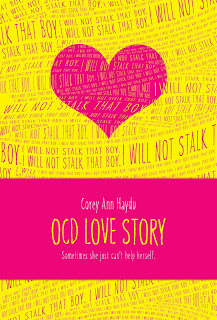
Bea has OCD.
Bea doesn't identify as someone with OCD. She doesn't exhibit a lot of the trademark signs of the mental illness -- she doesn't really have compulsions or obsessions. Or at least, she tells herself she doesn't, and by extension, she convinces us as readers she doesn't have them. But slowly, as OCD Love Story unravels, Bea comes around to the idea that the things she does which other people don't do are precisely what mark her illness.
It's a school dance, and Bea's at the local all-boys academy. When the power dies, she finds herself sitting beside a boy with whom she strikes up an immediate conversation and kinship. She can't see Beck, but she knows she likes him right away. Even though he's tentative about her seeing him, she pushes. She wants to know who this boy is. But when the lights come back on, she's lost him and she knows nothing of him except his name. Maybe she'll see him again. Maybe not.
When Bea shows up for her next therapy appointment, it's all routine: she gets there early enough to grab the seat nearest Dr. Pat's office, where she can listen to the session before hers. It's a couple -- Austin and Sylvia -- and they're having issues. Bea takes copious notes about them, including what they're saying to one another, what their challenges might be, what she imagines their life at home must feel like. As Dr. Pat calls her into the office that day, she drops not only the bomb that she's suspecting Bea's challenges are due to OCD (and specifically the compulsions) and worse, Bea's going to start going to group therapy. Such therapy would be good because it would allow for meeting other people who are suffering with similar problems and more importantly, it would provide her an opportunity for exposure therapy.
And it's at the first group therapy session when Bea reunites with Beck. How many local boys have that name? She recognizes his voice. She recognizes him as him.
Beck has OCD. The things he told her about the night at the dance make sense. And more than that, Bea becomes aware of how his OCD manifests quite quickly. Their first "date" happens when Beck asks her to take him to the gym after therapy. Because he told his mother his sessions lasted three hours, when really, they were more like an hour. Those additional two hours were for his working out.
Even though she sees it immediately in him, Bea is blind to how her own OCD manifests. We as readers are blind to this for a long time, too. She is an expert at hiding it and revealing it to herself -- and us by extension -- slowly. Rather than tell us, rather than even showing us, she experiences it, and as readers, we experience it right along with her. We are there as she drives to Austin and Sylvia's house over and over. We are there as she pinches her thigh hard to stop herself from acting upon something. We are there as she panics when she starts to drive and when she has to pull over. We are there when she tells us about the scrapbook from the boy who did something violent. As Bea has her ah ha moments thinking about her past, particularly when she tells us why it is she ended up in Dr. Pat's office for therapy, we see more of the backstory. We see more of the forward progress in these moments, as well.
Bea is very sick, but she doesn't show it off in the ways people would expect of someone with OCD. She fixates on people and on their lives. She stalks people she becomes fascinated with, even at the expense of those relationships in her life which are good and strong. Bea has a solid family unit, and she has a great best friend. But those are things she can't wrap her mind around. She sees other people's lives as so much more interesting and so much better than her own, even when it's clear they are not. But she fears tremendously that things could change in an instant. She worries about sharp objects, about violence, about glass and knives and the pain they could potentially inflict upon anyone she loves and cares about.
She does have a huge moment later in the story recognizing this -- and it's one of the most painful moments of exposure therapy that she could have never planned. When she comes to understand that the image in her head of Austin and Sylvia's rock star life isn't what she'd imagined, Bea has her understanding of just how ill she is and yet at the same time, just how okay she is.
OCD Love Story has a bit of a misleading cover. This isn't a light-hearted romance. There is indeed a budding romance here, and there's sex and talk about sex (Bea's not really ashamed of being sexually active), but I wouldn't call what Bea and Beck experience traditional in any way. Those looking for a romance won't really find it here -- there isn't hand holding, there aren't first kisses, there aren't moments that are really swoon-worthy. In many ways, I'd argue that almost makes the romance more authentic, but that's to the real world, rather than the fictional world.
OCD Love Story does not have a misleading title, though: this is a love story through and through. It's a love story to Bea coming to understand herself and coming to love herself, despite the very serious issues she's tackling with internally. It's Bea wrestling with loving those who are around her and support her because of and in spite of these things. Lish, her best friend, is an excellent friend. Haydu took serious time to craft a fully-fleshed cast of supporting characters in Bea's life, and even though her lens is skewed throughout, we as readers recognize this skewed perception. She allows us this, telling us in one breath than Lish is doing something really nice for her and then immediately questioning whether Lish is sick of her or is just being nice because she feels obligated to do so.
Haydu's writing is strong. Bea's got a great voice, and she's convincing in how she presents herself both to herself and to us as readers. She doesn't seem sick. But slowly, she breaks. And as she breaks, it's not because she's presenting readers a show. It's because she's realizing she herself isn't strong enough to keep up the charade, and she knows she doesn't need to be (I think we can attribute part of that to her relationship with Beck -- he's never there to save her, but she's there beside him as he struggles with his problems and she realizes it's okay to be weak and allow people in when she needs it). This book will get under your skin as you watch someone who appears so strong crumble a little bit. Then crumble a bit more. Then break completely. And yet, as you watch this happen, you can't help but feel like it's going to be okay for her. There will be a bottom to the fall, but there's a nice net there to catch Bea. The craft here is solid.
Pass OCD Love Story to those readers who want a straight on, unashamed look at mental illness. This is the kind of book that will realign their thoughts on what OCD is -- it's not just one of those challenges that can be the butt of a joke. You don't have OCD if you check your alarm's settings three times before bed every night. It's not something that is easily recognized by those suffering, and Haydu does immense service to that with Bea. In many ways, this book is scary. It's scary to experience the suffering right along with a character in a way that feels like it's happening to you, too. In many ways it's voyeuristic, but it's through this lens that the book is so successful and powerful. An excellent, worthwhile debut novel. I'm eager to see where Haydu will go next.
I liked this book so much I called it my July favorite over at Book Riot's monthly roundup.
OCD Love Story is available now. Review copy received from the publisher or picked up at BEA or something.







 Related StoriesThe Theory of Everything by Kari LunaStarglass by Phoebe NorthOver You by Amy Reed
Related StoriesThe Theory of Everything by Kari LunaStarglass by Phoebe NorthOver You by Amy Reed
Published on August 01, 2013 22:00
July 31, 2013
Mini-Trend: Seven Kingdoms
I love maps in my fantasy novels. There was a period in my teen years when I wouldn't check out a book unless it had a map. A detailed, colorful one, preferably. Looking at so many maps over the years, I've picked up on a few trends. The most recent one I've noticed: seven kingdoms, seven realms, seven countries.
Often the number is included in the official name of the world. Sometimes it's just a descriptor. Seven has always been popular with fantasy writers, I think (J. K. Rowling has said the number has always held a special magic for her, and she's not alone), so I suppose it's not surprising to see. But a reader can't be blamed when the worlds all blend together in her head as a result.
Links lead to places where you can see the official maps. I feel certain there are some I missed - let me know in the comments.
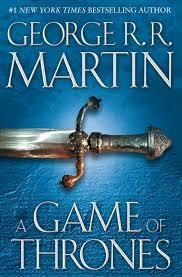

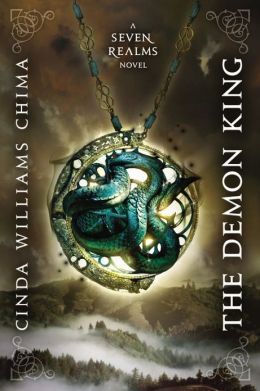
The Seven Kingdoms of Westeros
from the Song of Ice and Fire series by George R. R. Martin
I suspect some of the popularity of the seven kingdoms/realms/countries can probably be traced to Martin. Despite the much-used phrase "the seven kingdoms," even some fans are confused as to what the seven kingdoms really are - the seven countries of the region before they were conquered and united by Aegon, which happens before the book series begins.
The Seven Kingdoms
from the Seven Kingdoms trilogy by Kristin Cashore
It's not only the name of the world, but the name of the book series as well.
The Seven Realms
from the Seven Realms series by Cinda Williams Chima
Same for Chima's series, which I'm sure I'll get around to reading some day.
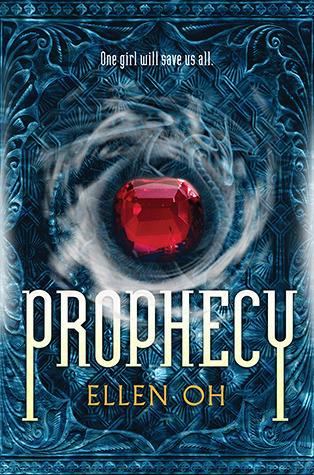
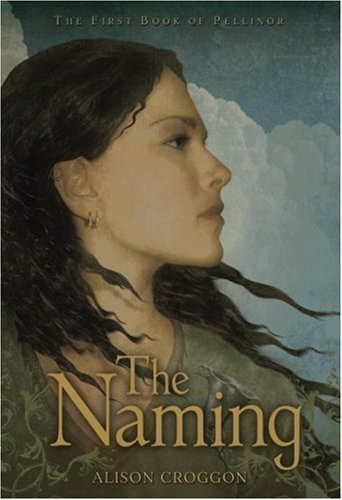
The Seven Kingdoms
from Prophecy by Ellen Oh
By the time I got to this book I was thoroughly confused (though Oh's series is refreshingly based on a historical culture of the East rather than the West).
The Seven Kingdoms of Annar
from the Pellinor series by Alison Croggon
I've had the first book in this series sitting on my shelf for a while, but haven't dug in.
The Lumatere Chronicles barely escapes this list with eight countries in its world of Skuldenore (though it can be argued that with Lumatere in such an ambiguous place for most of the book, it essentially only has seven).






 Related StoriesGorgeous by Paul RudnickEtiquette and Espionage by Gail CarrigerThe Runaway King by Jennifer Nielsen
Related StoriesGorgeous by Paul RudnickEtiquette and Espionage by Gail CarrigerThe Runaway King by Jennifer Nielsen
Often the number is included in the official name of the world. Sometimes it's just a descriptor. Seven has always been popular with fantasy writers, I think (J. K. Rowling has said the number has always held a special magic for her, and she's not alone), so I suppose it's not surprising to see. But a reader can't be blamed when the worlds all blend together in her head as a result.
Links lead to places where you can see the official maps. I feel certain there are some I missed - let me know in the comments.



The Seven Kingdoms of Westeros
from the Song of Ice and Fire series by George R. R. Martin
I suspect some of the popularity of the seven kingdoms/realms/countries can probably be traced to Martin. Despite the much-used phrase "the seven kingdoms," even some fans are confused as to what the seven kingdoms really are - the seven countries of the region before they were conquered and united by Aegon, which happens before the book series begins.
The Seven Kingdoms
from the Seven Kingdoms trilogy by Kristin Cashore
It's not only the name of the world, but the name of the book series as well.
The Seven Realms
from the Seven Realms series by Cinda Williams Chima
Same for Chima's series, which I'm sure I'll get around to reading some day.


The Seven Kingdoms
from Prophecy by Ellen Oh
By the time I got to this book I was thoroughly confused (though Oh's series is refreshingly based on a historical culture of the East rather than the West).
The Seven Kingdoms of Annar
from the Pellinor series by Alison Croggon
I've had the first book in this series sitting on my shelf for a while, but haven't dug in.
The Lumatere Chronicles barely escapes this list with eight countries in its world of Skuldenore (though it can be argued that with Lumatere in such an ambiguous place for most of the book, it essentially only has seven).







 Related StoriesGorgeous by Paul RudnickEtiquette and Espionage by Gail CarrigerThe Runaway King by Jennifer Nielsen
Related StoriesGorgeous by Paul RudnickEtiquette and Espionage by Gail CarrigerThe Runaway King by Jennifer Nielsen
Published on July 31, 2013 22:00
Public Library Association Conference -- I'll be there!

I put in a proposal to present at next spring's Public Library Association Conference with three of my closest professional colleagues (who are obviously also good friends): Drea, Katie, and Angie. You may remember that the three of us presented together at the YA Lit Symposium last fall in St. Louis, so we know we work well together and when we get talking about library-related stuff, we love to talk about it out loud and with others.
We waited patiently -- and maybe impatiently -- to hear back. And today we heard that our proposal was accepted.
So you'll be able to hear us talk in Indianapolis on a panel we called "Beyond Duct Tape Wallets: Offering Dynamic, Effective, and Community-centered Teen Programs." It's not specifically about books or reader's advisory, though I certainly plan on talking about both in terms of programming and reaching your community's teens.
And maybe best of all is that I plan on talking a lot about this summer and what I learned about teen programming. Sure, I've been doing some form of teen programming now for four years, but I still learn something new. This year I learned how much failure you can have trying new things and when you go back to super basic stuff, sometimes you can have great success.
Also, expect some passive programming talk.
What maybe excites me most about this is not that I get to talk and share with these three librarians who constantly inspire and motivate and cheerlead me, but I get to listen to two other very close librarian friends and colleagues as they talk about tween programming at the library. No, I won't tell you who just yet because they get to make that announcement themselves.
I haven't talked much on STACKED about what a challenging summer this has been professionally for me, but it has been. Today, though, between this and working some things out with myself mentally with the ending of our summer library club, I'm feeling almost refreshed and excited again about what I do (I always like it a lot -- I love it, in fact -- but it is easy to wear yourself out on the things you love).
I hope I get to see some of you next spring in Indianapolis!








Published on July 31, 2013 16:17
July 30, 2013
Fat is not a disability: It's a book deal breaker
I just wrapped up another day of doing the Shred.
It's been a year since I started putting conscious effort into working out, and I've stuck to it.
There have been some months where I've gone more days not doing it than days I have done it. There've been weeks that have passed without doing a single workout.
But then there are days like today, and the day before, and the day before, where I get into the workout, find that groove, hit flow, and walk away not just sweaty and gross, but feeling higher than anything and super pleased with the workout.
In the past year, I've lost nearly 40 inches total.
And maybe 10 pounds or so.
I get down on myself about my weight periodically, but I've always been fat. I've always had it on my body, and it's just a part of who I am. In the last year of working out, I've gained a much stronger sense of confidence in my own body and in the physical state in which I exist and inhabit. I won't lie and say that losing double-digit inches in my hips and my waist hasn't boosted my confidence and made me really happy -- especially when it comes to trying on clothes or being able to not think twice about whether something I want to try on will or won't fit.
But more of my confidence comes from being fat and being able to push myself through an intense, ass-kicking workout and seeing it through until the end. My fat body is able to move and to sweat and to endure for 30 minutes without collapsing, without falling in on itself, without my heart stopping in the middle.
My fat body is awesome for this, and I am grateful every damn day I can do it. My fat body is so awesome for being able to do this that I reward my fat body with doing it again. And again. And again.
I will never be thin, and this is a fact I accepted at nearly 300 pounds a few years ago, and it's a fact I accept now, weighing significantly less than that.
My fat isn't something I am regularly conscious of. It's just a part of who I am, and I accept it as a reality of my existence. I'm okay with it. My body does and feels good things.
I like my body even though it's fat. I like my body even if you or anyone else does not.
This is on my mind again after reading Becky's great post over at Book Riot on Book Deal breakers. What are those things in a book which turn the book off to you completely? I agree with nearly every single thing on Becky's list, and I add one more: books which are about the fat body and that play into fat tropes. More specifically, books about fat girls that play into the fat girl tropes.
Almost all of the time, these books use their fat characters as the story. It is the fat on their body which drives the entire narrative. The character usually hates herself for her fat body because there is nothing worse than being a fat teenaged girl. You don't get dates. You don't have friends. You don't fit into clothes. Furniture and stairs creak and groan under the pressure your body exerts upon it. Trying on clothes in the dressing room is a joke. Sometimes, fat people themselves are the joke -- the ones around you or with you, even.
These books center on the issue of fat -- being fat means something bad here, and the way to happiness, to friendship, to sexual enjoyment, to being able to move and dance and exist is through getting rid of the fat. Be it through a "healthy new dieting routine," through gastric bypass surgery, through working out and "putting a little effort into your look." Miraculously, those changes add up to a character better understanding herself and her place in the world and when her body finally fits the acceptable mode, she is accepted.
It makes me feel ashamed that the message of most YA books featuring fat characters is that your body is wrong, it's going to kill you, it's going to hold you back, and it's not worth the space it takes up on this planet. Because this is a message we already send teenagers and if you don't believe it, I point you to a recent story about how the Boy Scouts of America won't let obese scouts go to the annual Jamboree (which is an event centered all about being active and having fun but fat bodies aren't allowed that privilege because fat bodies aren't real bodies).
Being fat isn't a disability. Being fat is a physical state of being.
Why is it that fat people only have books featuring characters like them when the plot of the book centers around the most obvious thing -- their being fat? Why is the character's entire being and existence wrapped up in this one element of who they are? And why is it that losing weight is the end goal? You can be perfectly happy and healthy and active and confident and love for yourself at any size or shape or weight. It is not about the state of the body; it's about the state of the mind. Fat is a thing you have, not a thing you are.
The more we continue to believe that it is about the state of the body, rather than the state of the mind, the more we continue to tell fat people their state of existence isn't okay.
We tell them their stories -- as they are -- do not matter. That their stories will not matter until they reach a certain, socially-constructed, mythical ideal shape. Many times that won't matter, either, because then their stories are about how they did it. How they "beat" fat.
I want to see more books that feature fat characters -- fat girls especially -- because I wish that body-positive, empowering books like Susan Vaught's My Big Fat Manifesto and Simmone Howell's Everything Beautiful had been around when I was a fat teenager and everywhere I looked, I was made to feel like I did not matter. Because the thing these books do that so many fat character-centered YA books don't do is they show that fat characters wear their bodies as they do and still have rich, fulfilling, exciting, dynamic, and interesting lives beyond their shape. That they have dreams and goals and their bodies are going to help them get there, rather than hold them hostage or disable them completely.
What I want is for a teen to pick up a book that features a fat character who isn't a silly sidekick or a laughing stock. Who isn't seeking a way to better herself by losing weight. There are some authors doing this, but we need more (just like we need more who are writing about diversity or sexuality). I give kudos to authors like Rainbow Rowell, who has written a fat girl in Eleanor in Eleanor & Park -- but I must install this caveat to my statement of what we need.
We need more books featuring fat characters that are done with enough conviction -- given enough of a life and story and narrative and richness of their own -- that they stand alone and stand up to the intolerance that some readers might bestow upon them. In other words, I think that having to explain why your character is fat or talk about that choice and what it may or may not mean in a blog post assumes a lot about your readers, and it also maybe suggests that your character doesn't have enough to her to stand on her own and be what she is without elaboration. I don't think it's necessary to consider the "how fat" question at all.
It stings me to read representations of fat hate, even if it's meant to be "subtle" or throwaway, as I suspect is the case in David Levithan's Every Day, where A is essentially a klutzy, worthless monster at 300 pounds and disgusted and repulsed by it.
This is already what we see and experience.
For so many years, I believed that my being fat would hold me back. And it has in some ways -- but never because of my body. It's held me back because of other people's perceptions of what a fat person can or should be doing.
I was shamed for my body once, by a colleague -- a boss -- at a program, in front of a group of teenagers. To this day, I remember standing there as she made a fat joke to this group of teenagers who were having a really good time at a program we were running. After she told it, she turned to me, covered her mouth with her hand, and said "no offense, I'm sorry Kelly." I felt two things: first, tiny and insignificant as a person for being reduced to just a fat body in the eyes of a professional and second, dread that my teens had to see that whatever they may experience in their lives now may actually never "get better" when they become adults.
We can do better than this.







It's been a year since I started putting conscious effort into working out, and I've stuck to it.
There have been some months where I've gone more days not doing it than days I have done it. There've been weeks that have passed without doing a single workout.
But then there are days like today, and the day before, and the day before, where I get into the workout, find that groove, hit flow, and walk away not just sweaty and gross, but feeling higher than anything and super pleased with the workout.
In the past year, I've lost nearly 40 inches total.
And maybe 10 pounds or so.
I get down on myself about my weight periodically, but I've always been fat. I've always had it on my body, and it's just a part of who I am. In the last year of working out, I've gained a much stronger sense of confidence in my own body and in the physical state in which I exist and inhabit. I won't lie and say that losing double-digit inches in my hips and my waist hasn't boosted my confidence and made me really happy -- especially when it comes to trying on clothes or being able to not think twice about whether something I want to try on will or won't fit.
But more of my confidence comes from being fat and being able to push myself through an intense, ass-kicking workout and seeing it through until the end. My fat body is able to move and to sweat and to endure for 30 minutes without collapsing, without falling in on itself, without my heart stopping in the middle.
My fat body is awesome for this, and I am grateful every damn day I can do it. My fat body is so awesome for being able to do this that I reward my fat body with doing it again. And again. And again.
I will never be thin, and this is a fact I accepted at nearly 300 pounds a few years ago, and it's a fact I accept now, weighing significantly less than that.
My fat isn't something I am regularly conscious of. It's just a part of who I am, and I accept it as a reality of my existence. I'm okay with it. My body does and feels good things.
I like my body even though it's fat. I like my body even if you or anyone else does not.
This is on my mind again after reading Becky's great post over at Book Riot on Book Deal breakers. What are those things in a book which turn the book off to you completely? I agree with nearly every single thing on Becky's list, and I add one more: books which are about the fat body and that play into fat tropes. More specifically, books about fat girls that play into the fat girl tropes.
Almost all of the time, these books use their fat characters as the story. It is the fat on their body which drives the entire narrative. The character usually hates herself for her fat body because there is nothing worse than being a fat teenaged girl. You don't get dates. You don't have friends. You don't fit into clothes. Furniture and stairs creak and groan under the pressure your body exerts upon it. Trying on clothes in the dressing room is a joke. Sometimes, fat people themselves are the joke -- the ones around you or with you, even.
These books center on the issue of fat -- being fat means something bad here, and the way to happiness, to friendship, to sexual enjoyment, to being able to move and dance and exist is through getting rid of the fat. Be it through a "healthy new dieting routine," through gastric bypass surgery, through working out and "putting a little effort into your look." Miraculously, those changes add up to a character better understanding herself and her place in the world and when her body finally fits the acceptable mode, she is accepted.
It makes me feel ashamed that the message of most YA books featuring fat characters is that your body is wrong, it's going to kill you, it's going to hold you back, and it's not worth the space it takes up on this planet. Because this is a message we already send teenagers and if you don't believe it, I point you to a recent story about how the Boy Scouts of America won't let obese scouts go to the annual Jamboree (which is an event centered all about being active and having fun but fat bodies aren't allowed that privilege because fat bodies aren't real bodies).
Being fat isn't a disability. Being fat is a physical state of being.
Why is it that fat people only have books featuring characters like them when the plot of the book centers around the most obvious thing -- their being fat? Why is the character's entire being and existence wrapped up in this one element of who they are? And why is it that losing weight is the end goal? You can be perfectly happy and healthy and active and confident and love for yourself at any size or shape or weight. It is not about the state of the body; it's about the state of the mind. Fat is a thing you have, not a thing you are.
The more we continue to believe that it is about the state of the body, rather than the state of the mind, the more we continue to tell fat people their state of existence isn't okay.
We tell them their stories -- as they are -- do not matter. That their stories will not matter until they reach a certain, socially-constructed, mythical ideal shape. Many times that won't matter, either, because then their stories are about how they did it. How they "beat" fat.
I want to see more books that feature fat characters -- fat girls especially -- because I wish that body-positive, empowering books like Susan Vaught's My Big Fat Manifesto and Simmone Howell's Everything Beautiful had been around when I was a fat teenager and everywhere I looked, I was made to feel like I did not matter. Because the thing these books do that so many fat character-centered YA books don't do is they show that fat characters wear their bodies as they do and still have rich, fulfilling, exciting, dynamic, and interesting lives beyond their shape. That they have dreams and goals and their bodies are going to help them get there, rather than hold them hostage or disable them completely.
What I want is for a teen to pick up a book that features a fat character who isn't a silly sidekick or a laughing stock. Who isn't seeking a way to better herself by losing weight. There are some authors doing this, but we need more (just like we need more who are writing about diversity or sexuality). I give kudos to authors like Rainbow Rowell, who has written a fat girl in Eleanor in Eleanor & Park -- but I must install this caveat to my statement of what we need.
We need more books featuring fat characters that are done with enough conviction -- given enough of a life and story and narrative and richness of their own -- that they stand alone and stand up to the intolerance that some readers might bestow upon them. In other words, I think that having to explain why your character is fat or talk about that choice and what it may or may not mean in a blog post assumes a lot about your readers, and it also maybe suggests that your character doesn't have enough to her to stand on her own and be what she is without elaboration. I don't think it's necessary to consider the "how fat" question at all.
It stings me to read representations of fat hate, even if it's meant to be "subtle" or throwaway, as I suspect is the case in David Levithan's Every Day, where A is essentially a klutzy, worthless monster at 300 pounds and disgusted and repulsed by it.
This is already what we see and experience.
For so many years, I believed that my being fat would hold me back. And it has in some ways -- but never because of my body. It's held me back because of other people's perceptions of what a fat person can or should be doing.
I was shamed for my body once, by a colleague -- a boss -- at a program, in front of a group of teenagers. To this day, I remember standing there as she made a fat joke to this group of teenagers who were having a really good time at a program we were running. After she told it, she turned to me, covered her mouth with her hand, and said "no offense, I'm sorry Kelly." I felt two things: first, tiny and insignificant as a person for being reduced to just a fat body in the eyes of a professional and second, dread that my teens had to see that whatever they may experience in their lives now may actually never "get better" when they become adults.
We can do better than this.








Published on July 30, 2013 22:00
July 29, 2013
Reviews, "Non-Fantasy Readers," and Finnikin of the Rock
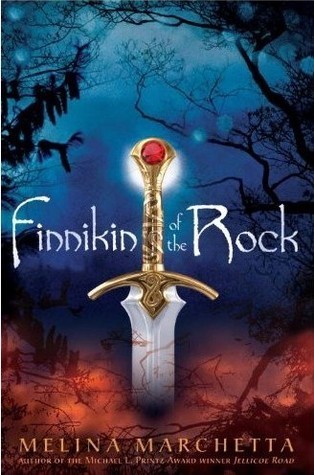
I read Melina Marchetta's lovely Finnikin of the Rock this past weekend. I thoroughly enjoyed it - it's exciting, plotted well, and full of thorny, complex characters. It has magic and adventure and love and revenge and kingdoms and threats of war and all that other good stuff I look for in a rousing high fantasy read.
As I always do, I read a lot of reviews of the book. I'm a review-reader. I read reviews before I read the book, while I'm reading the book, and after I'm done reading it. I noticed that many readers had come to Finnikin of the Rock and its sequels via Marchetta's other titles, which are acclaimed and award-winning and, most importantly, realistic novels.
Most of these readers who came to her fantasy books via her non-fantasy ones really enjoyed Finnikin. I love to see this. I love that fantasy can gain new fans this way, even if those readers are reluctant to pick up other fantasy titles. It's how I come to read a lot of non-genre (out of my own comfort zone) works, too.
The problem arises when I see a review that claims that a book like Finnikin is "not really a fantasy novel." I see this sort of thing in a lot of reviews of acclaimed genre titles, particularly if those titles are by authors who don't usually write genre fiction. With Finnikin, I see it in almost every single one of the reviews where the reviewer states they don't normally read fantasy. It's a strange statement to make for a book like Finnikin - that it's "not really fantasy" - since Finnikin is high fantasy and therefore the most obvious kind of fantasy - set in a completely different world, with strange names and magic to boot.
When I read the reviews further, though, it became apparent that the reason these readers don't feel that Finnikin is truly fantasy is because it is "really" about things that humans in the Real World can relate to: identity, loss, family. That it's about the characters and how they cope with these things, how they relate to each other, how they explore their situation and rise above it (or don't).
But Finnikin is not at all unusual in this regard, because these things are what all good fantasy books are about. I promise. That's what makes them good books. If they're not about these things, they're just bad books - and you can find bad books in any genre. There are plenty of realistic books that place plot (or setting) on a pedestal and sacrifice character (or theme) at its altar. To say that fantasy does this more than other genres is just wrong - and insulting.
I was raised on fantasy novels. They're what I've read since I knew how to read. They're layered with meaning, full of substance. They've taught me more about myself and the people around me than I can explain. I love how creative they can be, how empowering, how beautiful their language, how intricate their plots. I love that they can create people and things so fantastical, so completely strange, but also make me feel like I know those unbelievable things and people like I do my own self. When a person claims that a great fantasy book isn't "really" fantasy because it has depth, because it has meaning, because it says true things about life, I object strongly. I know it to be false, and it seems like an unwarranted slight against a genre that still endures critical ridicule despite its current popularity.
Here are just a few examples of some high fantasy YA novels I've read recently that all incorporate very human themes (read: that are all good books). Sarah Beth Durst's Vessel is about a girl whose family had tremendous expectations for her, and she disappointed them completely. Now she's lost, abandoned by the ones she loves, desperately seeking a new home and an identity in a world that has rejected her. Jennifer Nielsen's The False Prince features a boy without a family who is also trying to find a place for himself, trying to regain the honor he felt he lost by a decision that was forced upon him years ago. Anything written by Shannon Hale - check out The Goose Girl for a prime example - is sure to include lovely, evocative writing and well-meaning but flawed characters.
If you read the descriptions above, without the titles, you wouldn't know they belonged to fantasy books. At their hearts, all good books are about how people (or other sentient beings) grow and change. They're always about us.
I think a lot of this sort of misconception springs from ignorance. If someone has only read one kind of fantasy book before - and let's be honest, it's probably The Lord of the Rings - she or he may have assumed other fantasy novels are just like it. But equating one fantasy novel with another is just like equating one realistic book with another. It would be ridiculous if someone said "Oh, I didn't like To Kill a Mockingbird, so I don't think realistic books are for me. If I like another realistic book, it must be because it's not really realistic."
As I thought about this more, I tried to get to the heart of what the critics were saying. They love Finnikin, but don't care for fantasy usually. Why, then, does Finnikin speak to them so strongly while other fantasy novels don't? If this were any other book, I'd assume that the fantasy elements were light and easily overlooked, but that's not the case here. Finnikin is steeped in traditional high fantasy tropes. Its religion, cultures, quests, kingdoms, magic, and themes - particularly the search for identity and a lost homeland - are all trademarks of high fantasy. In fact, I'd say that Finnikin treads no new ground at all in any of these areas. For all its excellent writing, it's not a very creative book.
Which leads me to my conclusion - Marchetta is a fantastic writer, and that's why people love this book. It's perfectly legitimate to not enjoy fantasy elements. I get that completely. Magic isn't for everyone. But when the writing is just so darn good, sometimes it's hard not to like a book in spite of the magic. That's what happened to me with A. S. King. I'll read everything she writes - which is almost always realistic - simply because her writing is just that good.
There may be other reasons, of course. The world-building is pretty standard, and not incredibly detailed or varied, so it's easier for people who don't normally read fantasy to follow it, I think. For many readers, elements like that are a distraction (whereas for mega fantasy fans, they're enhancements). You get a lot of readers who can't stand The Lord of the Rings because of this. But to claim that the fantasy elements somehow prevent real, deep meaning or substance from existing in all but a treasured few is disingenuous. (And for all its endless detail and pointless digressions, Lord of the Rings has an incredible amount of substance.)
I'd like to encourage readers who don't normally read fantasy to think more broadly about the genre. Most fantasy has magic, yes, but the magic isn't the entirety of the book. In any good fantasy, the magic (you can insert whatever traditional fantasy element you like instead of "magic") will be a vehicle for the characters and their growth, in much the same way that the plot elements of a realistic novel are the vehicle for its characters.
Finnikin of the Rock is a fantasy. If you liked it, you like fantasy. Maybe not all of it, maybe not even most of it, but you do like some of it. Rather than denying it by saying you don't normally read fantasy, be proud of it. This is a great book. It's worthy of your love - and it's worthy because it's a fantasy, not because it's not.








Published on July 29, 2013 22:00
July 28, 2013
So You Want to Read YA?: Guest Post by Heidi Zweifel (Middle School Librarian & blogger at YA Bibliophile)
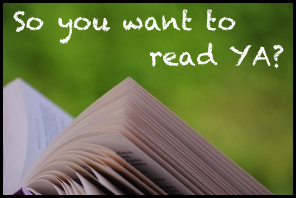
This week's guest post comes from the blogger/librarian who actually inspired the first incarnation of this series, Heidi Zweifel. She's a local-to-me middle school librarian who asked me simply where to tell teachers they should begin if they wanted to give reading YA a shot.
Of course, I had to ask her to weigh in and round out the second batch of posts on this very topic.
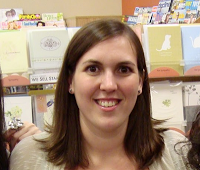
Heidi is a middle school library media specialist. She gets to spend her day with seventh and eighth graders so she never knows what to expect. The best part? Getting to talk about books with teens at least once a day! Heidi is passionate about reading and young adult literature. Her goal is to show her students that even if they don’t love reading they can find books that are interesting to them. Her passion of young adult literature is expressed on her blog YA Bibliophile. Follow her on twitter for ramblings on YA lit, pictures of her adorable nieces and nephew, and far, far too many tweets about nothing in particular.
When I think of how I fell in love with young adult literature it’s not individual books that come to mind. It’s authors. I’m the kind of obsessive reader who finds an author they love and must read everything that author has ever written right now. This was especially true when I first started reading YA. Below you’ll find a few of the authors that showed me YA lit can be smart and clever and not “speak down” to it’s readers. They showed me that books can tackle the real issues that teens deal with and not have an “after school special” feel They showed me that YA books can be fun and light or dark and twisted or some combination of the two and still be authentic. If you’re looking at trying out young adult literature I highly suggest you start with any thing by any of these authors.
John Green: If you’ve been to my blog or you follow me on twitter you probably know that I am a total John Green fangirl. He is my favorite author. Ever. I stumbled across An Abundance of Katherines at my local public library. It was on display in the teen section and I passed it up a couple times. The whole math aspect threw me. I am so not a math girl. After seeing it a few times I added it to my pile. Best. Decision. Ever. It was funny and clever and there were footnotes! Basically it was everything I wanted from a book. I eagerly snapped up Looking for Alaska and have impatiently waited for every new book from John Green since.
Holly Black: My first introduction to her writing was her Modern Faerie Tale series. I didn’t think I liked Faery books. Then I read Tithe. I don’t think I have the words to express how Holly Black’s writing captured me. She is so incredibly talented. The storytelling and world building blew me away. Her books were also some of the first I read that were considered “edgy.” Let’s just say the faeries aren’t of the Tinkerbell variety!
Chris Crutcher: This man published his first YA book in 1983. His books have been being challenged ever since. Crutcher is a child psychologist and doesn’t shy away from addressing issues like abuse and racism. Because of this, censors find his books to be “too mature” for teens. I find them amazing. They typically feature sports in some way but I would not call them “sports books.” There is so much more going on. Deadline is a great place to start. Another favorite of mine is Whale Talk. But really, they’re all good!
Tamora Pierce: I randomly picked up Alanna: The First Adventure when I got my job as a middle school librarian. The cover was pretty unappealing and I wanted to read it to decide if I should order an updated copy or just get rid of the book. Over the next couple months I read every book ever written by Tamora Pierce. The worlds that she creates are fascinating and her characters are authentic and diverse. I recommend starting where I did with the Song of the Lioness quartet.
Sarah Dessen: Sarah is my go-to author for contemporary romance with a bit “more.” The public library is to thank for my introduction to her as well. The Truth About Forever was on display and the cover appealed to me. I couldn’t put it down. I loved the characters and the story. It just seemed like the people and places could be anyone, anywhere. I love accessibility in a book! I also love that many of her books are set in the same fictional locations so we get glimpses of characters we’ve met before. Just Listen is my all time favorite of hers.
Other authors I read when new to YA lit: Lisa McMann, Melissa Marr, Robin McKinley, Scott Westerfeld, Maureen Johnson, and Meg Cabot.







 Related StoriesSo You Want to Read YA? Guest Post from Brandy Colbert (author of the forthcoming Pointe)So You Want to Read YA?: Guest Post from Sarah & Laura of Clear Eyes, Full ShelvesSo You Want to Read YA?: Guest Post by E. C. Myers (author of Fair Coin and Quantum Coin)
Related StoriesSo You Want to Read YA? Guest Post from Brandy Colbert (author of the forthcoming Pointe)So You Want to Read YA?: Guest Post from Sarah & Laura of Clear Eyes, Full ShelvesSo You Want to Read YA?: Guest Post by E. C. Myers (author of Fair Coin and Quantum Coin)
Published on July 28, 2013 22:00
July 25, 2013
July YA Debut Novels
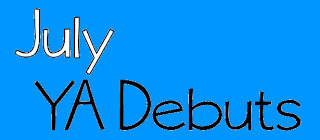
If you're keeping tabs on the YA releases from first-time authors, here's this month's installment. All descriptions come from Worldcat, unless otherwise noted, and you can check out prior monthly installments on June's post.
I've tried to get them all, but if there are any traditionally-published, first-time novels for young adults out in July that I've missed, let us know in the comments. We've linked to relevant reviews, and we'll update as we review novels throughout the year, as well.
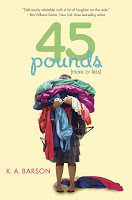
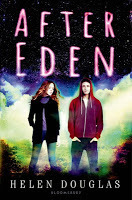
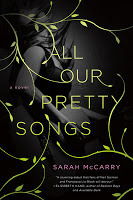
45 Pounds (More or Less) by K. A. Barson: When Ann decides that she is going to lose 45 pounds in time for her aunt's wedding, she discovers that what she looks like is not all that matters.
After Eden by Helen Douglas: Eden, sixteen, must choose between helping Ryan, a time-traveler, and her best friend Connor who, according to Ryan, is about to become famous through a significant scientific discovery that will, ultimately ruin the world.
All Our Pretty Songs by Sarah McCarry: In the Pacific Northwest, the bond between two best friends is challenged when a mysterious and gifted musician comes between them and awakens an ancient evil. Kelly talked a little about this book in her post on empowering female sexuality.
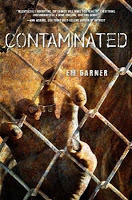
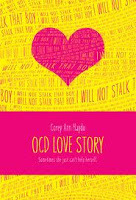
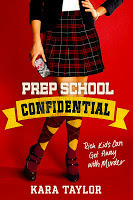
Contaminated by Em Garner: Velvet fights for her family's survival after a widespread contamination turns a segment of the population, including her mother, into ultra-violent zombie-like creatures
OCD Love Story by Corey Ann Haydu: In an instant, Bea felt almost normal with Beck, and as if she could fall in love again, but things change when the psychotherapist who has been helping her deal with past romantic relationships puts her in a group with Beck--a group for teens with obsessive-compulsive disorder.
Prep School Confidential by Kara Taylor: When Anne's misbehavior sends her from her Upper East Side prep school to a prestigious boarding school outside of Boston, her only goal is to get back home until her roommate, Isabella, is murdered and Anne decides to find out what happened, whatever the cost.
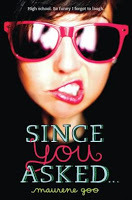
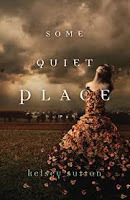
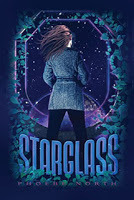
Since You Asked by Maureen Goo: Fifteen-year-old Holly Kim, the copyeditor for her San Diego high school's newspaper, accidentally submits a piece ripping everyone to shreds and suddenly finds herself the center of unwanted attention--but when the teacher in charge of the paper asks her to write a regular column her troubles really start.
Some Quiet Place by Kelsey Sutton: Seventeen-year-old Elizabeth Caldwell sees, rather than feels, emotions; they're beings who walk among us. The only emotion who engages with her now is Fear, and he's as desperate as Elizabeth is to figure out how she became this way.
Starglass by Pheobe North: For all of her sixteen years, Terra has lived on a city within a spaceship that left Earth five hundred years ago seeking refuge, but as they finally approach the chosen planet, she is drawn into a secret rebellion that could change the fate of her people.
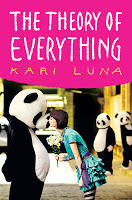
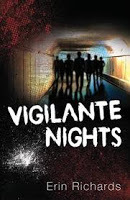
The Theory of Everything by Kari Luna: When fourteen-year-old Sophie Sophia journeys to New York with a scientific boy genius, a Kerouac-loving bookworm, and a giant shaman panda guide, she discovers more about her visions, string theory, and a father who could be the key to an extraordinary life.
Vigilante Nights by Erin Richards: His beloved twin dead, his future destroyed, Lucas forms a vigilante posse to take revenge on the gang members responsible. Can his new love, and his sister's voice from beyond death, stop Lucas from self-destruction?







 Related StoriesJune Debut YA Novels
Related StoriesJune Debut YA Novels
Published on July 25, 2013 22:00
July 24, 2013
The Theory of Everything by Kari Luna
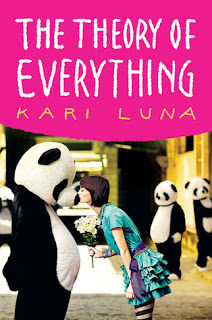
Fourteen-year-old Sophie Sophia and her mother just moved from San Francisco to the small town of Havencrest, Illinois (roughly 50 miles north of Chicago) after spending the bulk of their lives in Brooklyn, New York. Sophie is obsessed with eighties music, with dressing however the heck she feels like, and with figuring out what happened to her father.
Sophie's super-smart, passionate, and strange physicist dad disappeared just a few years ago, and that's what set her and her mother off on this series of cross-country moves. It was less about getting away and more about finding. Finding themselves. Finding a way through the grief. Finding a way to build something new.
It doesn't take long before Sophie's made herself a new friend in her physics class named Finny. But it also doesn't take long before she starts being visited by her shaman Panda named Walt. Is Sophie crazy or can these trips to a parallel world full of spiritually-guiding pandas be the way to find and connect with her long-long father?
The Theory of Everything is an enjoyable read, but it won't be one of my favorites. I certainly see how it's been compared to books like Going Bovine or even The Perks of Being a Wallflower, but I think it falls short of being a strong read alike to either of those titles. In many ways, Luna's debut novel fails to fully form Sophie as a memorable character in and of herself, which both Bray's novel and Chbosky's do. Much of what makes Sophie a character are the things surrounding her, rather than who she is in and of herself. More than that, she's hard to buy as a 14-year-old with the sort of knowledge and wisdom she has in consideration of the larger story, and secondary characters throughout the novel don't blossom beyond certain tropes.
The bulk of Luna's novel is realistic -- it's about Sophie learning to cope with big changes in her life. She's recently moved, and now she has to learn to fit into a small town where she is, of course, under the belief she'll be the only eccentric girl there who loves 80s music and funky clothes because no one in a small town has any culture to them. While I buy that belief wholeheartedly, especially given that Sophie is from Brooklyn and spent time in San Francisco, I took issue with her obsession with 80s music. I know I've blogged before, but in many ways, the trend of having characters who love anything 80s or setting a book in the 80s for the music/pop culture rings false to me. It reads more like authorial nostalgia than it does character development or authenticity. Do teens today like 80s music? Maybe some do. But as someone who was born in the mid-80s myself and who tries to stay moderately up-to-date in pop culture, a lot of the references or significance of this stuff is completely lost on me. I think we aren't quite yet removed enough from this era to see it or appreciate it for what it is in that historical context. I think in the case of Sophie, it wasn't so much about her character being a fan of the music. It felt more like a way for her character to be unique, which I didn't like. She had plenty of other qualities inherent to her character to do that for her.
Almost immediately in the story, Sophie befriends Finny in her physics class. Both geek out about string theory and the notion of parallel worlds, among other things. They're best pals quickly, and Sophie opens up to him about the real things going on in her life, including why she's living in Havencrest. Finny, on the other hand, gives almost nothing to Sophie -- maybe because Sophie is a little self-absorbed she misses it, but I think that in many respects, Finny just isn't a full character. What we know about him is that he's gay and he's easily convinced to skip school and hop a train with Sophie for a whirlwind adventure in Brooklyn to look for her father. We learn later on he's the type of person who can establish relationships quickly, period, as he does just that with the new woman in Sophie's father's life. I wish he'd been a lot more developed because he was interesting. I wondered about his own life in small town Illinois, about what it was like for him to be gay in that situation, and I wondered, too, if he had any friends besides Sophie. In many ways, Finny felt like simply the gay sidekick in the story.
The Theory of Everything isn't entirely realistic though -- at least, it might not be. What makes Sophie truly unique is that she often falls into a parallel world, where she's greeted by a shaman panda named Walt. He is friendly with her and he assures her many times that things are going to be okay.
The thing about these episodes Sophie experiences, though, is that they're the same episodes her own father used to experience. They're the same kinds of episodes that would happen and cause him to disappear for days at a time and to raise worries with her mother and his other loved ones. These moments of disconnecting with the real world and falling deeply into this made up one were the real reason he disappeared and never came back, as well as why Sophie and her mother left Brooklyn.
What makes Luna's book go the magical realism direction, though, is that it's possible these episodes aren't a method of coping nor a mental illness. They could all be explained by physics in some capacity. Are there parallel worlds we can fall into? If so, how can we do that? If parallel worlds exist, are Sophie and her father both capable of entering and exiting them in as much a physical way as they are able to enter them in a mental way. Sophie can bring objects back with her from her episodes, only making these questions tougher to answer.
There is a lot of suspension of disbelief necessary for the story beyond the episodes. Sophie and Finny run off to Brooklyn together without either of their parents becoming too concerned -- and remember, they're 14. There's also a really underdeveloped and somewhat random romantic interest given to Sophie mere days after her move, and the guy stays patient and understanding with her, despite the fact she flakes out on him more than once. So there is a "love story" here in terms of a romance, but it's shallow and secondary; the real "love story" might instead be to family.
The ending is a bit unsatisfying, as I'm not sure it draws any conclusions or further considerations for Sophie beyond giving her closure in the understanding that sometimes, there simply is not closure (which is a fair takeaway for her and for the reader, even if I don't necessarily like it).
Writing-wise, there's nothing particularly memorable here. It suits the story, and it doesn't get bogged down. My only qualm might be that it felt like there was too much trying to be crammed in in an attempt to give Sophie a quirkiness that she didn't need to have because it already existed within her -- starting with her name.
Despite the fact this wasn't one of my favorite reads in recent memory, those looking for something different and fun, despite the heavier themes of grief and mental illness, will likely appreciate The Theory of Everything. I can see readers who like Natalie Standiford's brand of quirk in How to Say Goodbye in Robot or Confessions of the Sullivan Sisters finding this a satisfying read, as would those readers who want their stories with a little bit of science-fantasy. Likewise, readers who like A. S. King's magical realism, particularly Everybody Sees the Ants, will likely find this a great read alike. There's probably a lot to be discussed among the two when it comes to mental illness and coping mechanisms.
Review copy received from the author. The Theory of Everything is available now.







 Related StoriesStarglass by Phoebe NorthOver You by Amy ReedVortex by S. J. Kincaid
Related StoriesStarglass by Phoebe NorthOver You by Amy ReedVortex by S. J. Kincaid
Published on July 24, 2013 22:00



